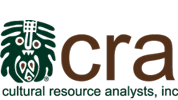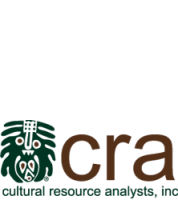Geophysical Studies and Remote Sensing
CRA is proud to offer a whole suite of Geophysics and Remote Sensing services in both Archaeology and Historic Preservation. We specialize in all manner of archaeo-geophysical survey, UAV mapping, and three-dimensional (3D) modeling. Our specialists have the knowledge and experience to map anything that fits your archaeological or historical needs.
Geophysical Studies
At CRA, we stress the use of multiple survey techniques to gain maximum information in a cost-efficient manner. That’s why, since 1987, CRA has pioneered the integration of near-surface geophysical techniques with fieldwork to reduce costs and improve the quality of cultural resource evaluations. Our geophysical survey techniques include: magnetometry, ground-penetrating radar (GPR), electromagnetic induction (electrical conductivity and magnetic susceptibility), and electrical resistance to locate potential archaeological sites. No matter the technique, we emphasize using state-of-the-art data collection procedures with high speed, high-resolution multi-channel equipment and processing routines that allow us to continually increase the utility and accuracy of geophysical survey data.
Near-surface geophysical survey techniques are rapid, non-destructive techniques for identifying all manner of past occupation. From identifying complete settlements to seasonal camp sites, applying the right geophysical technique can lead to a significantly better understanding of archaeological sites. In an ideal world, geophysics would be performed before and in tandem with traditional survey and excavation, but we at CRA recognize the need for efficient cost-effective solutions and work with our clients to employ the most appropriate survey, case by case. Additionally, geophysical methods commonly overcome sampling issues posed by systematic shovel testing and can be performed considerably faster, leading to more accurate results at lower costs. When used correctly in combination with analysis of cartographic resources and other background data, the results of a geophysical survey may provide significant primary data to be used in decision making processes and at minimum better inform decisions about how to best deploy more cost-intensive field operations such as shovel testing and manual or mechanical excavations.
Geophysical Studies at CRA
CRA’s geophysical specialists have expertise in a variety of techniques, which can be matched to the unique needs and setting of your project.
TECHNIQUES
- Magnetometry, also called magnetic gradiometry
- Ground-penetrating Radar (GPR)
- Electromagnetic Induction (electrical conductivity and magnetic susceptibility)
- Electrical Resistance
- Down-hole Magnetic Susceptibility
APPLICATIONS
- Archaeological and Historical site survey
- Cemeteries
- Underground storage tanks
- Pipes
- Buried building foundations
- Roads
Geophysical Services

MAGNETOMETRY |

GROUND-PENETRATING RADAR |

ELECTROMAGNETIC INDUCTION |

ELECTRICAL RESISTANCE |
Remote Sensing
At CRA we incorporate the use of remote sensing technologies where and when applicable. In a broad sense, remote sensing encompasses all technologies that allow for the remote collection of data through specialized equipment which includes geophysics. However, remote sensing commonly refers to satellite, aerial, or terrestrial based mapping of the surface.
The use of unmanned aerial vehicles (UAVs), commonly called drones, has greatly expanded in many sectors, especially cultural resource management. Drones have the ability to carry a variety of sensors, depending on the application, with the most common being cameras for photogrammetry or light detection and ranging (Lidar) equipment.
With increased computing power and optimized algorithms Structure-from-motion (SfM) photogrammetry has become easily accessible to professionals and the public alike. This method can be used to create high resolution 2D orthomosaics, digital elevation models (DEM), and even full 3D reconstructions from multiple overlapping images. This technology can be used for aerial or terrestrial mapping of the landscape or close-range mapping of objects. SfM can achieve high accuracy and precision comparable to Lidar/Laser Scanning in the right environment. Lidar also can achieve these high levels of accuracy, especially in more complex environments, but requires more specialized equipment, translating to higher costs. We work with our clients to determine which method best fits their project needs. CRA also employs structured-light scanning for three-dimensional modeling of small and mid-sized artifacts. This scanning technique projects a known light pattern onto objects and can reconstruct the object based on the distortion of this light pattern. In many cases, this technique can provide higher detail and accuracy of small objects, especially lithics.
Remote Sensing Studies at CRA
CRA’s remote sensing specialists have expertise in a variety of techniques which can be matched to your unique project needs.
TECHNIQUES
- UAV Aerial Imagery (RGB and Multi-spectral)
- SfM photogrammetry
- Structured-light scanning
- Lidar or laser scanning
APPLICATIONS
- High resolution orthomosaic creation
- Digital elevation and terrain modeling
- Vegetation health and NDVI calculation
- Bird’s eye view and landscape photography
- Three-dimensional modeling in archaeological and architectural applications including landscapes, historic structures, excavations, or small to large artifacts
Aerial Imagery/Lidar Visualization
Three-Dimensional Modeling
Textured Kirk Point
Untextured Kirk Point
Related Projects






